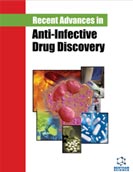Abstract
Background: There is a critical need for the discovery of novel and effective antibacterial or anticancer molecules.
Objectives: Amine-linked ursolic acid-based hybrid compounds were prepared in good yields in the range of 60-68%.
Methods: Their molecular structures were successfully confirmed using different spectroscopic methods including 1H/13C NMR, UHPLC-HRMS and FTIR spectroscopy. The in vitro cytotoxicity of some of these hybrid molecules against three human tumour cells, such as MDA-MB23, MCF7, and HeLa was evaluated using the MTT colorimetric method.
Result: Their antibacterial efficacy was evaluated against eleven bacterial pathogens using a serial dilution assay. Majority of the bacterial strains were inhibited significantly by compounds 17 and 24, with the lowest MIC values in the range of 15.3-31.25 μg/mL. Compound 16 exhibited higher cytotoxicity against HeLa cells than ursolic acid, with an IC50 value of 43.64 g/mL.
Conclusion: The in vitro antibacterial activity and cytotoxicity of these hybrid compounds demonstrated that ursolic acid-based hybrid molecules are promising compounds. Further research into ursolic acid-based hybrid compounds is required.
Graphical Abstract
[http://dx.doi.org/10.3390/ijms160921035] [PMID: 26404253]
[http://dx.doi.org/10.3390/ijms21165920] [PMID: 32824664]
[http://dx.doi.org/10.1002/cmdc.201300545] [PMID: 24623716]
[http://dx.doi.org/10.1016/j.lfs.2013.11.019] [PMID: 24333132]
[http://dx.doi.org/10.1016/j.bcp.2013.03.006] [PMID: 23499879]
[http://dx.doi.org/10.1016/j.fitote.2011.10.004] [PMID: 22051701]
[http://dx.doi.org/10.1016/j.cyto.2019.05.013] [PMID: 31302461]
[http://dx.doi.org/10.1016/j.ijantimicag.2019.07.015] [PMID: 31356859]
[http://dx.doi.org/10.1016/j.cbi.2008.08.010] [PMID: 18793624]
[http://dx.doi.org/10.1016/j.ejmech.2012.08.048] [PMID: 23124210]
[http://dx.doi.org/10.1016/j.ejmech.2013.05.029] [PMID: 23811086]
[http://dx.doi.org/10.1016/j.ejmech.2016.08.062] [PMID: 27639370]
[http://dx.doi.org/10.3390/ijms24043110] [PMID: 36834525]
[http://dx.doi.org/10.1016/j.bmc.2019.07.023] [PMID: 31324564]
[http://dx.doi.org/10.1016/j.tetlet.2021.153337]
[http://dx.doi.org/10.1093/eurheartj/ehy420] [PMID: 30060044]
[http://dx.doi.org/10.29245/2689-999X/2019/3.1155]
[http://dx.doi.org/10.1016/j.carres.2010.01.002] [PMID: 20116049]
[http://dx.doi.org/10.1007/BF02976156] [PMID: 18975163]
[http://dx.doi.org/10.1021/acs.oprd.7b00046]
[http://dx.doi.org/10.1016/j.tet.2005.08.031]
[http://dx.doi.org/10.1016/j.bmc.2022.116652] [PMID: 35180594]
[http://dx.doi.org/10.1016/j.bmcl.2012.02.009] [PMID: 22370266]
[http://dx.doi.org/10.1038/nrd.2018.168] [PMID: 30310233]
[http://dx.doi.org/10.1016/j.biopha.2018.12.119] [PMID: 30841473]
[http://dx.doi.org/10.1186/1475-2875-12-359] [PMID: 24107123]
[http://dx.doi.org/10.1186/1475-2875-13-418] [PMID: 25363455]
[http://dx.doi.org/10.1016/j.bmcl.2009.10.081] [PMID: 19896373]
[http://dx.doi.org/10.1016/j.ejmech.2016.08.021] [PMID: 27614409]
[http://dx.doi.org/10.3390/molecules21121629] [PMID: 27916811]
[http://dx.doi.org/10.1080/14756366.2017.1423067] [PMID: 29363364]
[http://dx.doi.org/10.3390/molecules22040619] [PMID: 28417930]
[http://dx.doi.org/10.3109/14756366.2011.625024] [PMID: 22145585]
[http://dx.doi.org/10.1007/s10870-011-0042-6]
[http://dx.doi.org/10.1080/22221751.2019.1568179] [PMID: 30866779]
[http://dx.doi.org/10.1128/AAC.00647-15] [PMID: 26033719]
[http://dx.doi.org/10.1016/j.bmcl.2012.08.071] [PMID: 22981334]
[http://dx.doi.org/10.1016/S0968-0896(00)00128-0] [PMID: 11003150]
[http://dx.doi.org/10.1016/j.ejmech.2004.07.005] [PMID: 15571868]
[http://dx.doi.org/10.1016/S0040-4020(00)00265-9]
[http://dx.doi.org/10.1016/S0039-128X(96)00114-6] [PMID: 8910969]
[http://dx.doi.org/10.1016/j.colsurfb.2017.10.052] [PMID: 29100129]
[http://dx.doi.org/10.4314/tjpr.v17i12.29]
[http://dx.doi.org/10.1021/acsomega.2c05061] [PMID: 36312373]
[http://dx.doi.org/10.1007/s10822-013-9644-8] [PMID: 23579614]
[http://dx.doi.org/10.1039/D1RA01390D] [PMID: 35423607]
[http://dx.doi.org/10.1186/1758-2946-3-33] [PMID: 21982300]
[http://dx.doi.org/10.1016/j.bmcl.2004.12.037] [PMID: 15686903]
[http://dx.doi.org/10.3390/molecules24122254] [PMID: 31212958]
[http://dx.doi.org/10.34172/PS.2021.12]
[http://dx.doi.org/10.1002/ijc.25123] [PMID: 20020492]
[http://dx.doi.org/10.1186/s13046-015-0251-5] [PMID: 26526352]
[http://dx.doi.org/10.1002/1878-0261.12155] [PMID: 29124875]
[http://dx.doi.org/10.1007/s10549-012-2289-9] [PMID: 23073759]
[http://dx.doi.org/10.1097/PPO.0b013e3181d24fc1] [PMID: 20164687]
[http://dx.doi.org/10.1158/1078-0432.CCR-06-3045] [PMID: 17671126]
[http://dx.doi.org/10.1016/j.semcancer.2022.04.002] [PMID: 35427766]
[http://dx.doi.org/10.3892/ol.2019.10561] [PMID: 31404298]
[http://dx.doi.org/10.1016/j.biopha.2016.08.030] [PMID: 27551755]
[http://dx.doi.org/10.1080/14756366.2019.1584622] [PMID: 30836795]
[http://dx.doi.org/10.3390/molecules20045360] [PMID: 25816079]
[http://dx.doi.org/10.1080/17843286.2018.1461754] [PMID: 29694303]
[http://dx.doi.org/10.1515/chem-2020-0085]
[http://dx.doi.org/10.1517/17425255.2.5.715] [PMID: 17014391]
[http://dx.doi.org/10.1371/journal.pone.0221331] [PMID: 31425543]
[http://dx.doi.org/10.1016/j.biopha.2021.112159] [PMID: 34536760]
[http://dx.doi.org/10.1007/s11095-011-0637-9] [PMID: 22161308]
[http://dx.doi.org/10.3892/ijo.2015.3016] [PMID: 25998227]
[http://dx.doi.org/10.3390/ph13120422] [PMID: 33255609]
[http://dx.doi.org/10.21873/anticanres.13481] [PMID: 31262859]
[http://dx.doi.org/10.2174/1389557518666180801110342] [PMID: 30068272]
[http://dx.doi.org/10.1177/0960327116660865] [PMID: 27481098]




























